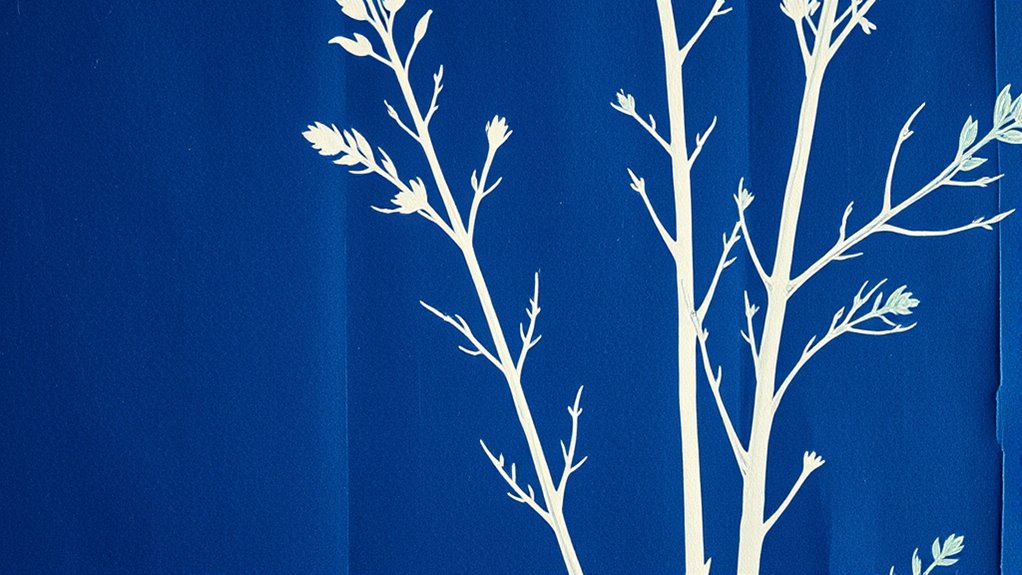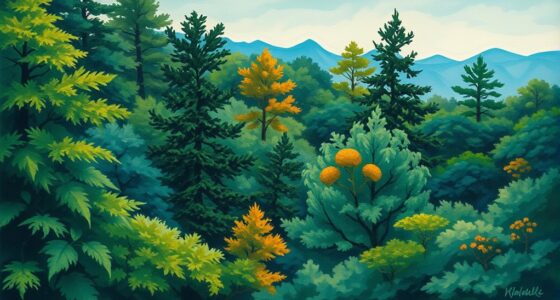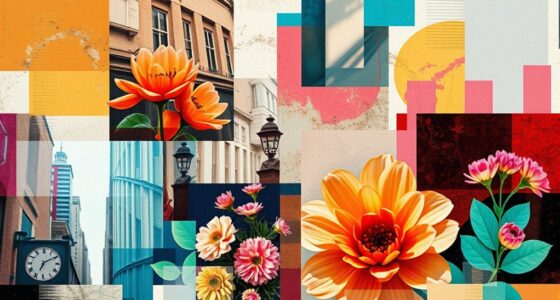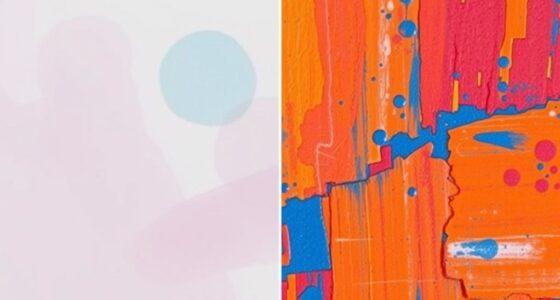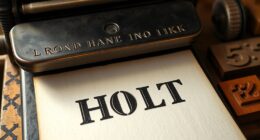Cyanotype printing allows you to create striking blueprints on paper through a simple process. You coat your paper with a mix of ferric ammonium citrate and potassium ferricyanide, let it dry, then place objects or negatives on the surface. Expose it to sunlight, which reduces the chemicals to reveal a vivid blue image. After rinsing, your blueprint forms. To explore detailed steps and tips for successful prints, continue discovering how to master this timeless technique.
Key Takeaways
- Prepare a surface (paper or fabric) with a mixture of ferric ammonium citrate and potassium ferricyanide.
- Place objects or negatives onto the coated surface and expose to ultraviolet light, such as sunlight.
- Expose until the image appears with a deep blue tone, usually 10–20 minutes depending on light intensity.
- Rinse the print with water to stop the chemical reaction and reveal the vivid blue blueprint.
- Allow the paper to dry completely for a durable cyanotype blueprint on paper.

Cyanotype printing is a mesmerizing alternative photographic process that allows you to create striking blue images using simple materials and straightforward techniques. This method, also known as blueprinting, has a rich history overview that dates back to the 19th century. It was developed by Sir John Herschel in 1842, initially used for copying architectural plans and botanical specimens. Its distinctive, vibrant blue hue quickly made it popular among scientists, engineers, and artists. Over time, cyanotype became more accessible and evolved with modern techniques, making it a favorite for both historical reproduction and contemporary art. Today, artists and hobbyists alike embrace cyanotype for its ease, affordability, and unique aesthetic appeal.
The process begins with coating a surface—traditionally paper or fabric—with a light-sensitive solution made from ferric ammonium citrate and potassium ferricyanide. Once the surface dries, you place your chosen objects or negatives on it, then expose the entire setup to ultraviolet light, typically sunlight. The UV light reduces the ferric compounds to ferrous salts, creating an insoluble blue compound called Prussian blue where light hits. After exposure, you rinse the material with water, washing away unreacted chemicals and revealing your vivid blue image. This straightforward process allows for endless creative experimentation, from detailed photographic negatives to simple natural objects like leaves or flowers.
Modern techniques have expanded cyanotype’s possibilities beyond traditional methods. Today, you can find pre-coated papers, making the process faster and more accessible. Digital negatives are also commonly used, enabling precise control over the image placement and detail. Some artists combine cyanotype with other media, such as painting or collage, to add depth and complexity to their work. Advanced techniques like toning the prints with tea, coffee, or other chemicals can produce different shades of blue or even sepia tones, giving your images a vintage feel. Additionally, some practitioners experiment with different substrates, including textiles or mixed media, to create textured or layered effects. Understanding the history of cyanotype enriches your appreciation and technique, connecting you to its roots and evolution.
Whether you’re recreating historical blueprints or exploring contemporary artistic expression, cyanotype offers an engaging way to connect with the roots of photographic history while harnessing modern innovations. Its simplicity makes it accessible to beginners, yet it also provides room for complex experimentation for seasoned artists. By understanding its history overview and applying modern techniques, you can unlock the full potential of this captivating process. As you delve into cyanotype printing, you’ll find a rewarding balance of science and art, where each print becomes a unique, luminous blueprint of your creativity.
Frequently Asked Questions
How Long Does a Typical Cyanotype Print Last Before Fading?
A typical cyanotype print can last decades before fading if stored properly. The print longevity depends on fading factors like exposure to light, air, and humidity. Keep your cyanotypes away from direct sunlight and high humidity to preserve their vibrant blue color. Using acid-free storage materials and framing them behind UV-protective glass also helps prevent fading, ensuring your cyanotype remains striking for years to come.
Can Cyanotype Printing Be Done on Fabrics or Other Materials?
Ever wondered if cyanotype printing works beyond paper? Absolutely! You can use it for fabric dyeing and textile art, creating stunning blue-toned designs on cloth and other materials. The process involves coating your chosen material with the cyanotype solution, exposing it to sunlight, and then developing the image. It’s a fantastic way to add a unique, vintage touch to your fabric projects, making each piece truly one-of-a-kind.
What Are Common Mistakes to Avoid During Cyanotype Process?
To avoid mistakes, always prioritize chemical safety by working in a well-ventilated area and wearing gloves. Proper paper preparation is vital—make sure your paper is clean, dry, and evenly coated with the cyanotype solution. Avoid overexposure to UV light, which can cause fading or uneven prints. Carefully rinse and dry your prints afterward to prevent damage. Staying attentive to these details guarantees vibrant, high-quality cyanotypes.
Is Special Equipment Needed for Large-Scale Cyanotype Printing?
You don’t need special equipment for large-scale cyanotype printing, but you should consider alternative chemicals for different effects or durability. To scale up, use larger exposure trays or UV light sources, ensuring even illumination. Digital transfer methods can complement cyanotypes, allowing you to prepare images beforehand. Just make sure your workspace is well-ventilated and you handle chemicals safely, especially when working with larger quantities or alternative formulas.
How Environmentally Friendly Is Cyanotype Compared to Other Printing Methods?
Cyanotype printing is quite eco-friendly compared to other methods because it uses non-toxic chemicals and requires minimal water. You can adopt eco-friendly practices by handling chemicals safely and disposing of waste properly. Its low energy consumption and the absence of harmful fumes make it a safer choice for the environment. Overall, cyanotype offers a sustainable alternative, especially when you prioritize chemical safety and eco-conscious techniques.
Conclusion
Now that you’ve mastered cyanotype printing, you hold the power to transform ordinary paper into stunning blue masterpieces. With just sunlight and a few simple materials, you can create artwork that rivals the beauty of the most renowned blueprints in history. Embrace this timeless process, and let your creativity shine brighter than a thousand sunsets. Your newfound skills unseal a world of artistic possibilities—so go ahead, make your mark with the mesmerizing magic of cyanotypes.
